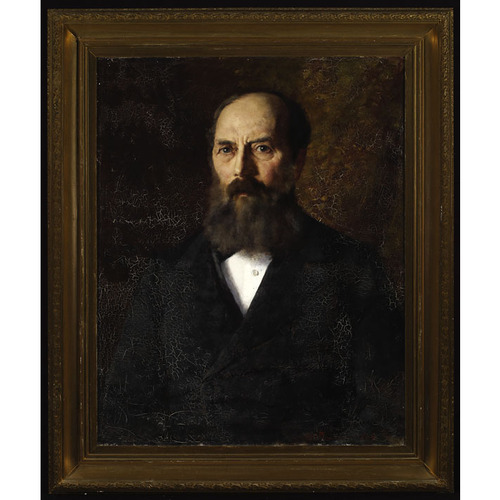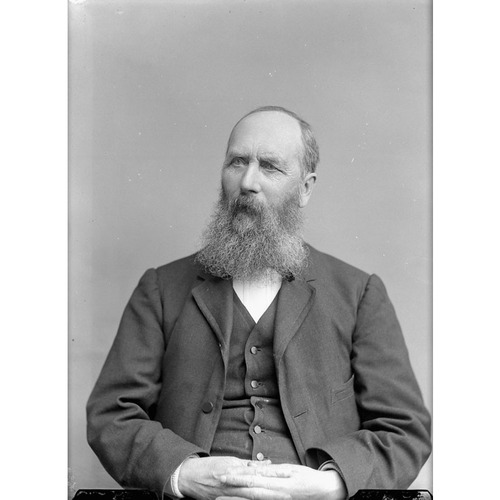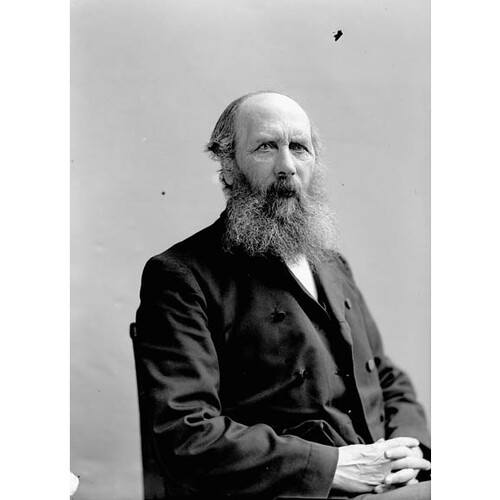BRYMNER, DOUGLAS, politician, journalist, and civil servant; b. 3 July 1823 in Greenock, Scotland, son of Alexander Brymner and Elizabeth Fairlie; m. there 1853 Jean Thomson, and they had nine children; d. 19 June 1902 in New Westminster, B.C., and was buried in Ottawa.
The fourth son of a banker and one-time editor of the Greenock Intelligencer, Douglas Brymner received his early education at the Greenock Grammar School. In the late 1840s he worked as a shipping agent and in 1850 he joined his brother Graham in the operation of a coal and lime business in Greenock, but ill health and overwork forced him to withdraw in 1856. The following year he immigrated to Canada with his wife and son. They settled at Melbourne, Lower Canada, where Brymner made an unsuccessful attempt at farming. Active in church and community affairs, he served two terms as mayor there. He turned to journalism and in 1864 moved his family to Montreal, where he assumed the editorship of the Presbyterian; at the same time he joined the editorial staff of the Montreal Herald and for a time represented it in the parliamentary press gallery in Ottawa. Brymner retained both editorial positions until the spring of 1872, when he left for Ottawa. He had accepted an appointment to the Department of Agriculture as clerk in charge of archives.
The impetus to collect and preserve records and documents pertaining to Canada’s past originated with the Literary and Historical Society of Quebec, which, led by Henry Hopper Miles*, had petitioned parliament in March 1871 for the establishment of an archives. The next year $4,000 was placed in the estimates of the Department of Agriculture for an investigation of archives in Canada. On 1 June Brymner took up his appointment, which was formally established by order in council on 20 June.
Thus, at age 48, Brymner made a fresh start in a new career, in an enterprise that was little understood and vaguely defined. The reasons for his selection are not clear. He had no connection with the Literary and Historical Society, though he appears to have had a general interest in historical matters. Whatever his qualifications, he tackled his new responsibilities with intelligence and enthusiasm. In three empty rooms in the basement of the west block on Parliament Hill, with no staff and not a single document in his custody, Brymner began what he described as “a task of more than ordinary difficulty.”
In his first year Brymner visited provincial capitals and other cities in search of old records that rightly belonged in Ottawa. In Montreal he discovered a cache of union-period financial records and in Halifax he investigated a collection of British military material, some 400,000 documents, that was destined for shipment to England. Brymner negotiated with British authorities and the records were transferred to Ottawa. Nothing would match the size or significance of this acquisition for many years to come.
Brymner went to London in 1873 and knocked on doors throughout the city, visiting the War Office, the Colonial Office, the Hudson’s Bay Company, the Public Record Office, the British Museum, and even the Tower of London in search of material relating to Canada. He recommended to agriculture minister John Henry Pope* that such documents in Britain be copied and bound for deposit in the archives. This recommendation was confirmed by Abbé Hospice-Anthelme-Jean-Baptiste Verreau, who had also been sent by the government in 1873 to search out material in Europe, strangely without knowledge at first of Brymner’s mission. But little was done to promote archival work during the lean middle years of the 1870s. Since Brymner had no staff to assist him and his meagre budget was reduced, he remained in Ottawa, where he painstakingly indexed most of the British military collection.
By 1880, this task completed, a rejuvenated Brymner once again turned his attention to acquisition. Following visits to Britain in 1881 and 1883, and to France in the latter year, he initiated a program of copying at the Public Record Office in London and directed his first assistant, Joseph-Étienne-Eugène Marmette, to begin investigative work in Paris on records relating to the French regime. The copying of Sir Frederick Haldimand*’s papers at the British Museum, begun modestly in 1878, was pursued in earnest four years later. Transcription was tedious and beset with problems. Brymner was a perfectionist and he personally inspected all copies as they arrived in Ottawa. Constantly annoyed by errors, sloppy handwriting, poor binding, and delays in transmittal, he experimented with photography as a means of duplicating documents.
Brymner’s systematic approach to acquisition expanded at home too. In the early 1880s he approached the families of those who had been involved in early events in Canadian history for donations of papers and records. He also started to build a library of books, newspapers, journals, association reports, government publications, and pamphlets, his objective being the creation of a great storehouse of Canadiana. To make his collections known, he decided to summarize or calendar them and publish the information in the archives’ annual reports. He started in 1881 with the Haldimand papers, a task that would take him 14 years to complete, and continued with the state papers for Upper and Lower Canada. Researchers took note. Genealogists, antiquarians, historians such as William Kingsford*, and government officials turned to Brymner for historical advice.
In the 1890s the copying work in Britain continued to occupy Brymner’s attention and was responsible for half of the archives’ annual expenditure during most of the decade. Similar work commenced in Paris. Approaching his 70th year, Brymner flirted with retirement, but he found it difficult to break away from the archives. In the fall of 1892 he moved to London to continue the search for documents; he would remain in Britain until the summer of 1894. While there, he investigated record-keeping practices in the British government and in other European countries, including Belgium, France, and Germany. Since 1875 in Ottawa Henry James Morgan* had been serving as keeper of the records in the Department of the Secretary of State, where he too collected older government records. Brymner’s study of foreign archives may have been motivated by a desire to end the rivalry and consolidate archival operations. His recommendation that a single record office be established fell on deaf ears until the spring of 1897. In February of that year the west block had been ravaged by fire and though no archival records were destroyed, Brymner’s holdings suffered some water damage. The loss by a number of departments of operational records prompted the government to appoint a commission of inquiry to investigate the state of public records. Following Brymner’s advice, it recommended the consolidation of all archival records. Yet Brymner’s dream of a properly constituted records office would not be realized until 1903, a year after his death.
Brymner’s personal life revolved around family and church. In Melbourne and Montreal he had been a prominent Presbyterian, serving as an elder at annual synod in 1858, 1861, 1864, 1867, and 1868. However, because of his opposition to the union of Presbyterian churches in Canada in the 1870s, he joined the Church of England. He was a founding member and later a warden of St Barnabas’ Church in Ottawa. After his wife’s death in 1884, he remained close to his family. He died in 1902 while he was visiting his son George Douglas, a banker in New Westminster. Of the four sons and one daughter who survived him, the best known is William*, a renowned artist. When William had moved to Paris in 1878 to study painting, he was liberally supported by his father, who later acted as his agent in Ottawa.
As head of the Canadian archives for 30 years, Brymner amassed an impressive library of books and pamphlets, and over 3,100 volumes of hand-copied and bound manuscripts. Because he was restricted by appropriations that remained unchanged, and inadequate, until the mid 1890s and often worked alone (Marmette and his successor, Édouard Richard, spent much of their time in France), Brymner’s accomplishment is all the more impressive. Acutely aware of the value of history, he realized that there could be no study without raw materials and so he dedicated himself to building collections that would allow historical research, and the historical profession in Canada, to expand and flourish. In recognition of his efforts, Queen’s College in Kingston awarded him an lld in 1892 and three years later he was elected a fellow of the Royal Society of Canada. Brymner’s legacy can be found in the annual reports of the archives, especially those published after 1882. The calendars and analyses of documents prepared by Brymner alone amount to more than 10,000 printed pages in the volumes that appeared between 1883 and 1902. Although the institution remained small throughout his tenure, Douglas Brymner alone was responsible for creating a solid foundation for Canada’s national archives.
The early development of the Canadian archives may be traced in a series of reports appended to the minister of agriculture’s annual reports for 1872 to 1903, available in Can., Parl., Sessional papers, 1873–1904. Douglas Brymner’s preliminary findings of 1872 and 1873 appear in the Sessional papers for 1873 and 1874 respectively, and H.-A.-[J.-] B. Verreau’s “Report of proceedings connected with Canadian archives in Europe” in those for 1875. After 1882 the appendices were also issued separately as Report on Canadian archives (Ottawa). Brymner prepared the reports for 1883–1901. A description of the early reports and their contents is provided in Index to reports of Canadian archives from 1872 to 1908 (Ottawa, 1909), published by the Canadian Archives (now the NA).
Douglas Brymner’s other publications cover a wide variety of topics. He is the author of two poems, “Charms of country life: an imitation,” in Rose-Belford’s Canadian Monthly and National Rev. (Toronto), 2 (January–June 1879): 429–30, and The twa mongrels: a modern eclogue (Toronto, 1876), issued under the pseudonym Tummas Treddles. An article, “The battle of Stoney Creek,” appears in the Hamilton Assoc., Journal and Proc. ([Hamilton, Ont.]), no.11 (1894–95): 36–44, and two others were published in the RSC Trans.: “The Jamaica maroons – how they came to Nova Scotia – how they left it,” 2nd ser., 1 (1895), sect.ii: 81–90, and “The death of Sir Humphrey Gilbert,” 2 (1896), sect. ii: 33–39.
His output also comprises a number of pamphlets, including Property and civil rights ([Ottawa], 1880) and two issued anonymously “by a Quebec Liberal”: Remarks on reciprocity and the Thornton–Brown memorandum (Montreal, 1874) and Commercial union: a study ([Ottawa?, 1888?]). Several concern his opposition to Presbyterian church union: Presbyterian union: a help to the intelligent discussion of the question; by an elder (Toronto, 1873), Faults and failures of the late Presbyterian union in Canada (London, Ont., 1879), Endowments of the Church of Scotland in Canada; evidence of Mr. Douglas Brymner before the Senate committee on private bills . . . (Toronto, 1883); he also issued a broadside on the same subject, Church of Scotland’s endowment ([Ottawa?, 1882?]), prepared jointly with T. A. McLean.
Finally, Brymner prepared translations from the French of Emile Petitot, Monograph of the Dènè-Dindjié Indians (n.p., [1878]) and Monograph of the Esguimaux Tchiglit of the Mackenzie and of the Anderson ([Montreal, 1878]); and J.-C. Taché, The Colorado potato beetle (Chrysomela decemlineata) and how to oppose its ravages ([Ottawa], 1880).
The NA’s Documentary Art and Photography Div. holds two portraits of Brymner, both by his son William.
City of Ottawa Arch., Beechwood Cemetery records. NA, MG 29, D25; RG 17; RG 35, ser.1; RG 37. National Gallery of Canada (Ottawa), William Brymner corr. Greenock Telegraph and Clyde Shipping Gazette (Greenock, Scot.), 9 Sept. 1882. Montreal Herald, 1–2 April 1872. Ottawa Citizen, 1–9 April 1872, 24–25 Feb. 1884, 20–29 June 1902. Ottawa Evening Journal, 20–29 June 1902. W. J. Anderson, “The archives of Canada,” Lit. and Hist. Soc. of Quebec, Trans., new ser., 9 (1871–72): 117–31. Armory and lineages of Canada; comprising the lineage of prominent and pioneer Canadians . . . , ed. H. G. Todd (New York, [1915]). Robert Campbell, A history of the Scotch Presbyterian Church, St. Gabriel Street, Montreal (Montreal, 1887). Can., Parl., Sessional papers, 1872–1904, public accounts of Canada, 1871–1903. Canadian men and women of the time (Morgan; 1898). Cyclopædia of Canadian biog. (Rose and Charlesworth), vol.1. Directories, Can., Prov. of, 1857/58; Montreal, 1861–72. D. C. Harvey, “Douglas Brymner, 1823–1902,” CHR, 24 (1943): 249–52. J. MacP. Le Moine, “The manuscript sources of Canadian history as revealed by our archives,” RSC Trans., 2nd ser., 1, proc.: lxvii–xc. Merrily on high in Ottawa: the story of the Church of St. Barnabas, Apostle and Martyr, 1889–1989 ([Ottawa, 1989?]). H. H. Miles, “On Canadian archives,” Lit. and Hist. Soc. of Quebec, Trans., new ser., 8 (1870–71): 53–71. Presbyterian (Montreal), 18 (1868)–25 (1872). Presbyterian Church of Canada in connection with the Church of Scotland, Acts and proc. of the synod (Toronto; Montreal), 1858–75. Richmond County Hist. Soc., Annals of Richmond County and vicinity (2v., Richmond, Que., 1966–68), 1. M. O. Scott, “Canadian celebrities; xix – Douglas Brymner, archivist,” Canadian Magazine, 16 (November 1900-April 1901): 206–8. I. E. Wilson, “‘A noble dream’: the origins of the Public Archives of Canada,” Archivaria (Ottawa), no.15 (winter 1982–83): 16–35. Armand Yon, L’abbé H.-A. Verreau: éducateur, polémiste, historien (Montréal, 1946).
Cite This Article
Glenn Wright, “BRYMNER, DOUGLAS,” in Dictionary of Canadian Biography, vol. 13, University of Toronto/Université Laval, 2003–, accessed December 30, 2025, https://www.biographi.ca/en/bio/brymner_douglas_13E.html.
The citation above shows the format for footnotes and endnotes according to the Chicago manual of style (16th edition). Information to be used in other citation formats:
| Permalink: | https://www.biographi.ca/en/bio/brymner_douglas_13E.html |
| Author of Article: | Glenn Wright |
| Title of Article: | BRYMNER, DOUGLAS |
| Publication Name: | Dictionary of Canadian Biography, vol. 13 |
| Publisher: | University of Toronto/Université Laval |
| Year of publication: | 1994 |
| Year of revision: | 1994 |
| Access Date: | December 30, 2025 |






